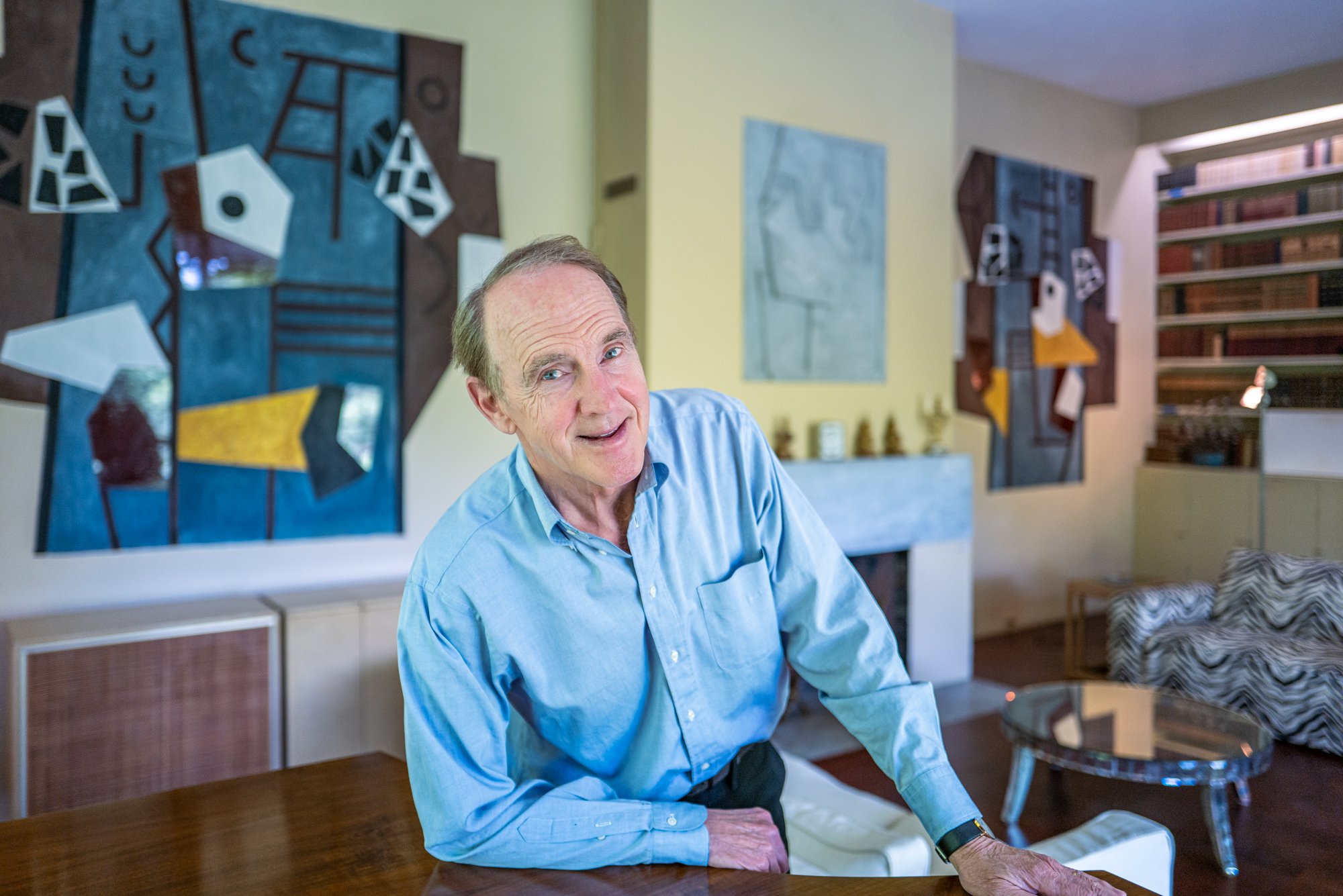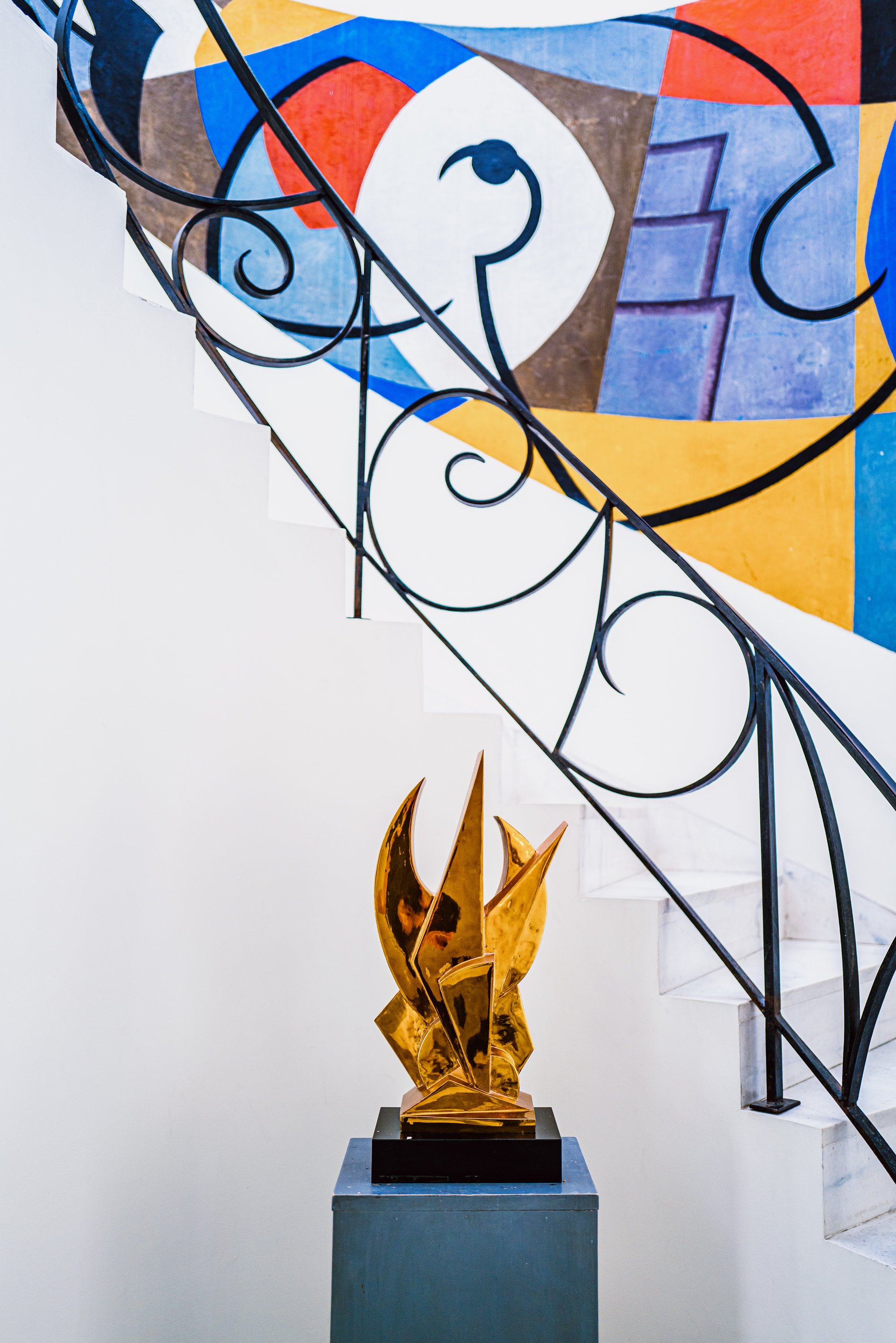The House that Modernists Built
FRELINGHUYSEN MORRIS HOUSE & STUDIO
IS THE EMBODIMENT OF AMERICAN ABSTRACT ART
By Ellen Spear // Photos by Jimmy ienner, Jr.
“ASKING ‘WHAT IS IT?’ SHUTS YOU DOWN,” says Kinney Frelinghuysen, director of the Frelinghuysen Morris House & Studio. He is talking about how to look at an abstract painting. Kinney is the nephew of Suzy Frelinghuysen and her husband George L.K. Morris. The couple’s artistic life in the Berkshires took place at the home they built and decorated in Lenox in 1941 to celebrate “the liberation of artistic language” through abstract art.
The Frelinghuysen Morris House & Studio is a modernist dream—displaying furniture by modern masters, original frescoes by the artists who lived there, and a collection of abstract and cubist art gathered by Morris to help with his own artistic development. He amassed a sterling collection, including works by Fernand Léger, Juan Gris, Pablo Picasso, and other seminal artists who were creating a new sensibility that was destined to define an era. Large floor-to-ceiling windows slide open, framing the bucolic views and creating a tension between the natural world and the abstract art in every corner of the house.
Sited on a 46-acre estate, the home was designed by architect John Butler Swann, who was commissioned to create a house that would join Morris’s existing studio and a garage into a harmonious whole. The stucco-and-glass confection ran over budget, forcing Morris to sell a Picasso to finance it.
Kinney grew up in an artistic family, and taking care of the house has been his life work. His father, Thomas, was a sculptor, and his work can be seen in the house. Kinney used to visit “Aunt Suzy” (his father’s sister) and “Uncle George” as a child. He remembers them as affectionate, humorous, and thoughtful—the kind of people Kinney could confide in about his teen-aged angst, and who listened and dispensed sensible advice. When he turned 20, Kinney realized that the house, the artwork, and the artistic pair’s lives had importance beyond the preservation of family memories.
Kinney Frelinghuysen, director of the Frelinghuysen Morris House & Studio in Lenox, was groomed to steward the house—with all of its contents and point of view—into the next generations. Suzy Frelinghuysen’s opera costumes also are on display.
A family friend encouraged Kinney throughout his hood to understand the significance of the art and environment. Kinney was groomed to steward the house—with all of its contents and point of view—into the next generations. George died in a car accident in Stockbridge in 1975 at the age of 70. Suzy, who survived the devastating crash, was open to the idea that eventually her home and its contents could be an effective place for the public to learn about abstract art. She instructed in her will that the property be used “to further the understanding of abstract art in America.” Suzy passed away in 1988.
The house provides the context for understanding modernism. The living room—with its recently restored leather floor, zebra-patterned couches, and mirrored coffee table—is arranged so that conversation with others in the space happens naturally and unavoidably. This was a departure from interior design conventions at the time and was the idea of a prominent industrial designer Gilbert Rohde, whose pieces are on display throughout the house. Two frescoes by Morris flank the fireplace, bookends to his sculpture over the mantle.
“Sitting in this room is a great privilege,” says Kinney. The furniture and appointments in Suzy and George’s living room would be prized items in any dwelling being decorated today. Kinney thinks the revival of interest in this style is simply because enough time and enough generations have passed since it was new. But there is more to it. The furniture’s clean lines, unexpected shapes, and use of contrasting color quietly challenge the status quo.
Frelinghuysen Morris House provides the context for understanding modernism.
The living room, the striking dining room, and the other spaces come together to create an immersive experience for exploring and understanding abstract art and the time in which it was created. Kinney says the idea behind the museum is an intimate look at the artists’ “fight for the liberation of artistic language. We stand for this period of time.” The house museum is open to the public seasonally. Its unassuming driveway on Hawthorne Street in Lenox, just past Tanglewood, is easy to miss. The drive takes visitors through the lush grounds, past an outdoor fresco on the wall of a breezeway that con- nects the house to the garage.
Kinney, who loves conducting tours of the place, also thinks that looking at abstract art is good for the brain. Once a viewer lets go of trying to understand “what,” then one can free the brain to interpret and, as Kinney puts it, “find the drama and narrative that speaks to you.” Finding drama and narrative is a good description of the experience of the entire house. Kinney doesn’t understand how people could live with a lot of figurative art in their homes (“all those portraits looking down at you all the time”). He prefers the persuasive, non-verbal language of abstract.
Moving from the dramatic curved staircase in the foyer with its colorful mural beckoning you upward, to the dining room that sur- rounds you in more murals, to the tranquil bedrooms with striking furniture, built-ins and paintings at every turn, Kinney stops to reflect that his goal is to have visitors relive the conversations that occurred in the house about abstract art and the struggle to establish its impor- tance for all time.
The house, sited on a 46-acre estate, was designed by John Butler Swann.
George’s studio wing serves as a pantheon for modernist and cubist art. Leger, Gris, Picasso, as well as Joan Miró, Georges Braque, Albert Eugene Gallatin, Jean Arp, and others are on display—a survey of the painters from whom George sought to learn and find his own style. Kinney provides a tutorial of looking and really seeing, encouraging an encounter that simulates what it would have been like to view art at the time when it was new to the world. Suzy’s opera costumes also are on display. She had a successful career with the New York City Opera before retiring in 1951 and turning her attention to art full time, encouraged by her husband.
Kinney says 100 years from now, he would like the house and its arrangement to be “exactly the same,” though he concedes the leather floor in the living room would probably have to be preserved once more. He says the museum is “not trying to morph into something else.” Rather, Kinney sees the house as an object that defines “The Shock of the New,” as modern art has been called, and the Frelinghuysen Morris House provides a window on experimentation, innovation, and the artistic struggles that define the work of making art that makes us think differently about our world.
Frelinghuysen Morris House & Studio is located at 92 Hawthorne Street in Lenox. It is open from June 23 to Columbus Day, Thursday to Sunday from 10 a.m. to 4 p.m. Timed tickets are required. frelinghuysen.org








